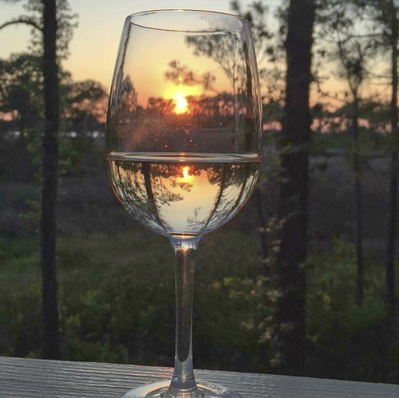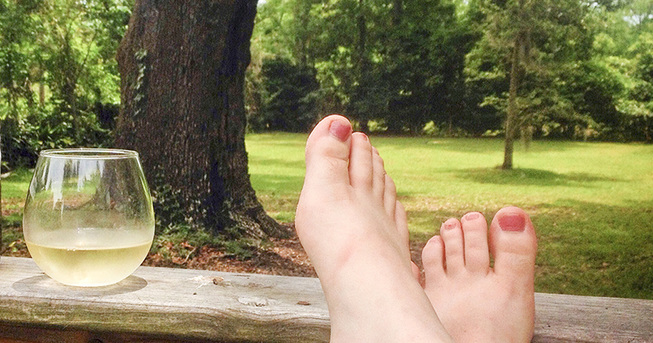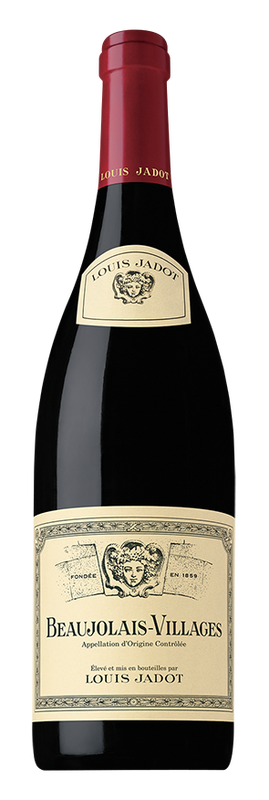|
Porch-friendly wines pair well with hot weather, summer menus and long conversations with good friends. Read on for some great suggestions by wine aficionado, Anna Speer.
Not yet high summer, no longer early spring: we're in a shoulder season. What are the best warm weather wines for this time of year? Read on, wine lovers. I'll admit it — I love shoulder seasons. Late spring to early summer in Mississippi offers what is, without a doubt, one of my favorite shoulder seasons in the world. Everything is in bloom, we have more daylight and we are treated to warm, pleasant days and cool, crisp nights. If we are very lucky, we even get a breeze to keep away the mosquitoes. Grills get lit and, as meals and parties move from living rooms to porches, we start looking for wines to take the edge off the afternoon sun.  photo by Anna Speer photo by Anna Speer
In order to be "porch friendly," wines must meet a few standards in my book. Bigger, tannic red wines can be overwhelming on warm days, and many white wines with higher alcohol content will come off overly harsh and heavy in the heat. We want something that is food friendly as well as delicious on its own.
A classic choice in this broad, subjective category is Riesling. This sweet white wine originated in Germany, but grows well in most of Western Europe and the U.S. It is immensely versatile; ranging from off-dry to richly sweet with color and flavor profiles as varied as the countries in which it is grown. Often falling under the shadow of its much sweeter cousin, Moscato, Riesling is, in my opinion, a greatly underrated wine. This is not to say that Moscato is a wine to be dismissed — far from it. More on that another time. That being said, I would invite all Moscato drinkers to branch out. In our market, we have access to Rieslings that are predominantly semi-sweet with notes of tree fruits and citrus. For a deeper, richer option, look for late-harvest Rieslings; these will showcase apple and honey notes. As a whole, these wines offer an approachable sweetness paired with a crisp acidity that is ideal for hot weather after an essential solid 2-hour chilling in the fridge. For those who prefer dry wines to sweet ones, let us turn to the world of Pinot Gris and Pinot Grigio. This grey-skinned grape takes its name from its country of origin (the French word for grey is gris); when these grapes are grown across the border in Italy, they take on the grigio appellation. This single grape is used to craft two very different and widely popular styles of wines. Savignon Blanc lovers, take note: both these styles cater to your tastes.
The first, Italian-style Pinot Grigio, is light colored, lighter bodied and generally lower in alcohol content. Made from grapes that are harvested earlier in the season, these wines feature a more neutral taste while maintaining the bright acidity of the wine berries.
The second style is the Alsatian Pinot Gris, which showcases notable spiciness, full body and a higher alcohol content. Where Pinot Grigio is harvested young and meant for early consumption, Pinot Gris will cellar and age well. Look to Italy and Oregon for the best and most accessible options for both of these delicious varieties. A note of advice before moving on: some Pinot Gris, particularly those grown in warmer climates, can have alcohol contents of up to 14 percent. In these cases, chilling the wine and keeping it cold is absolutely essential. Allow them to get too warm and you'll find yourself with a nose full of rubbing alcohol.
Steals, Deals, Splurges
"Steals" are usually under $10, "Deals" in the $15 range, and "Splurges" are in $20 - $40 range. These wines are available in the Bay-Waveland area.
Steal: Chateau Ste. Michelle Reisling (2014)
Deal: Louis Jadot Beaujolais Village (2014) Splurge: Santa Margarita Pinot Grigio (2014) Comments are closed.
|
Categories
All
Archives
July 2024
|
Shoofly Magazine Partners
Our Shoofly Partners are local businesses and organizations who share our mission to enrich community life in Bay St. Louis, Waveland, Diamondhead and Pass Christian. These are limited in number to maximize visibility. Email us now to become a Shoofly Partner!




























 RSS Feed
RSS Feed























